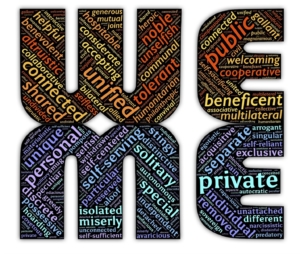Building a “We” vs “Me” Culture

We all know there’s no “I” in team and yet, we often see executives making basic mistakes in communications that would indicate otherwise. Particularly in the client service business, it’s crucial to think carefully about how you and your team are presenting information.
For example, in the agency world, clients are serviced by account teams comprised of individuals who are often responsible for different pieces of work. However, each piece of work is important to the overall success of the account. Without content, media and advertising don’t work. Without the right messaging, nothing works, and so on. Clients need to know that the team, although working on different pieces, is a comprehensive unit.
If your employees are updating clients during a meeting and talking in terms of “Me” vs “We,” the team will come across not as a comprehensive unit working together towards a common goal, but rather as a group of individuals more worried about getting credit for their piece. This is not conducive to building client confidence.
So as a manager, what can you do?
- Lead by example – lead with a team-oriented mindset. Make it clear that wins and losses are universal and not exclusive.
- Use the right language – pay attention to the language that you use when presenting teamwork to the client. Don’t separate out your part vs other team members. Teach them to do the same. This is especially important to ensure that the client knows the team unit is strong and working together to produce the best results. “We researched the market and suggest these three key messages,” vs. “I researched the market and Tom wrote up these three key messages,” for example.
- Provide recognition in the right ways – Instead of calling out an individual’s contributions directly to the client, always emphasize the team effort. Internally, provide rewards and recognition for each contributor that can incentivize other team members as well. Companies such as Corporate Rewards Worldwide can help.
- Have your team’s back – Over the years, our managers have had clients call to discuss individuals on their team – both good and bad. One thing we always emphasize is how the team works together to make things happen. While one person might have a greater strength in a certain area than another person, they are all important to the winning equation. If a client feels someone isn’t performing as well on a task as someone else, we’ll offer to move things around or, depending on the situation, ensure them that they aren’t seeing the entire picture – emphasizing how the individual is a team contributor and that perhaps their job is less client facing than another but just as important to the process. You can address these issues directly with your team later, and make changes or corrections as needed.
It isn’t a complicated proposition to build a team-oriented culture, but it has to be a consistent effort, and definitely takes some training. People are naturally driven to point out their contributions – which is understandable and welcomed. But in a business where they’re servicing a client, they need to understand that the best time and place to do so is with their boss, not to the client. Of course, it’s important to ensure recognition – both good and bad – happens regularly but it must be done in a way that doesn’t jeopardize the client relationship. Remind employees of the greater good that comes from not only working as a team, but thinking and presenting as one.

 At the risk of stereotyping myself, and my peers, it seems to me that most PR personalities are talkers, spinners and strategists, but rarely are they quiet listeners or observers. This observation is based on my own experience in PR over the last decade or so. I also speak from that rare position of listener.
At the risk of stereotyping myself, and my peers, it seems to me that most PR personalities are talkers, spinners and strategists, but rarely are they quiet listeners or observers. This observation is based on my own experience in PR over the last decade or so. I also speak from that rare position of listener.